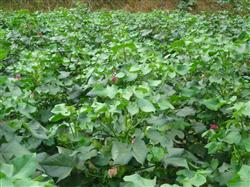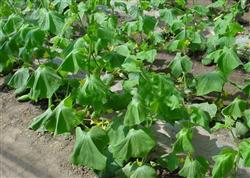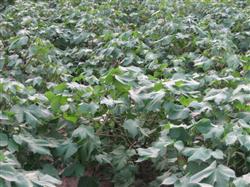What are the main cotton diseases and insect pests in summer and autumn?

What are the main cotton diseases and insect pests in summer and autumn? Please introduce the following main cotton diseases and insect pests and their control methods in summer and autumn: first, the occurrence trend of diseases and insect pests (1) Cotton blind bugs: it is expected to occur in the middle of the flowering and boll stage, and the cotton field will grow more seriously in the later stage. the peak period is from late August to early September, with an area of 700000 mu. (2) Cotton thrips: it is expected that the occurrence of cotton thrips is moderate in flowering and boll stage and moderate in some cotton areas. the occurrence peak is in the middle of August with an area of 650000 mu. (3) Spodoptera litura: the fourth generation is expected to occur moderately, the peak of low instar larvae is in late August, and the occurrence area is 650000 mu. (4) Cotton spider mites: it is expected that the occurrence of spider mites is moderate in the flower and boll stage and moderate in the hilly cotton region, with a peak period from the first ten days of August to the middle of August, with an area of 450000 mu. (5) Helicoverpa armigera: it is expected that the occurrence of the fourth generation is moderate and light, the peak spawning period is from 13 to 20 August, and the occurrence area is 160000 mu. (6) APHIS gossypii: it is expected that the occurrence of aphids in volt and autumn is moderate and light, with an area of 200000 mu. (7) Red bollworm: it is expected that the second and third generation light hair, non-Bt transgenic cotton and some cotton fields near the village are moderately light, with an area of 80 000 mu. (8) Fusarium wilt: with the decrease of temperature in late August, Fusarium wilt will show again in September. The occurrence degree of Fusarium wilt in old cotton area is moderate and heavy, with an area of 450000 mu, but the overall occurrence degree will be lighter than that in bud and flowering stage. (9) physiological diseases of potassium deficiency: in recent years, cotton growth in our city has occurred in a certain area, which began to occur in early June this year, and reached the peak in mid-late June. The incidence in the recent investigation is lighter than that in the same period last year. (10) Cotton boll disease: the occurrence of cotton boll disease is closely related to rainfall and rainy days. The peak period of perennial cotton boll disease in our city is from mid-August to early September. If there is heavy rainfall and more rainy days in this period this year, it will be beneficial to the prevalence of cotton boll diseases. 2. According to the above analysis, the overall control strategy of cotton diseases and pests in summer and autumn is to mainly control cotton bugs, cotton thrips, Spodoptera litura and some cotton leaf mites and cotton bollworms, as well as other pests such as red bollworm, cotton aphid, beet armyworm and so on. Pay attention to the occurrence of cotton wilt, potassium deficiency physiological diseases and cotton boll diseases from mid-August to early September. The specific prevention and control measures are as follows: 1. Strengthen field management. Combined with the measures of fertilization, topping, picking edge heart and spraying propranolol in cotton area, the vegetative growth and reproductive growth of cotton plant were regulated, the stress resistance of cotton plant was enhanced, and the number of eggs and larvae of cotton bollworm was reduced. 2. Remove the egg mass. Spodoptera litura adults like to lay eggs on tall, thick green plants, and the number of eggs in the middle and upper part of the plant is the most. Since early August, cotton fields have been inspected every other morning or evening to find egg blocks or newly hatched larval nests and take them out of the field in time for treatment. 3. Measures should be taken to clean the ditch and drain the cotton boll disease in time, remove the sick boll and spread the sun, remove the middle and lower old yellow leaves and spray pesticides to protect the cotton boll disease. 4. The prevention and control measures of cotton physiological diseases caused by potassium deficiency should be mainly agricultural measures, reasonable and timely fertilization and adequate potassium fertilizer. 5. Scientific and rational use of chemical pesticides. In the first ten days of August, it mainly controlled the third generation of Spodoptera litura in some cotton areas, as well as cotton leaf mites, red bollworm and other pests; in the middle of August, it mainly controlled cotton thrips, cotton leaf mites and cotton bollworm in some cotton fields, and other pests such as cotton bugs, cotton aphids, red bollworms, and other pests such as cotton bugs, cotton aphids, red bollworm and so on. In prevention and control, we should adhere to the prevention and control measures according to local conditions, classified guidance, up-to-standard prevention and control, scientific use of drugs, and give full play to the role of natural enemies in disaster control. Control indicators: the rate of mites in cotton leaf mites is 15%; the number of mites in cotton bugs is 3; the number of young larvae in 100 plants of cotton bollworm is 10; the number of three-leaf aphids in 100 plants of cotton aphids is 10000; the larvae of 100 newly hatched larvae of Spodoptera litura are clustered 1 nest, mainly to pick and treat insect nests, control before larval spread, and the top damage rate of cotton thrips is 20%. In prevention and treatment, we should pay attention to the quality of pesticide application, advocate alternating application, and use motorized sprayer to spray. The better time for control is after 4 o'clock in the afternoon. For the older larvae, cotton farmers should be organized to capture them artificially in the early morning. The following control agents are recommended: cotton thrips, cotton aphids: choose imidacloprid and imidacloprid, such as acetamiprid and ambroxol, aphid langjing, great hero, etc.; cotton blind bugs: fipronil (fipronil), acephate, chlorpyrifos, cypermethrin, etc.; cotton leaf mites: acarine, acaridin, avermectin, acetylene mites, abidaben, abamectin, etc. Cotton bollworm, Spodoptera litura: methyloxane, fenoylhydrazide, fluoridourea, phoxim + pyrethroid pesticides, probophos, cotton boll diseases: trimethoprim, carbendazim, Lubang 98, carbendazim, Paoxianke, etc. Click to get more cotton planting technology click to get more food crop planting technology
- Prev

What causes cotton to prevent acute wilting after rain?
What causes cotton to prevent acute wilting after rain? Please introduce the causes of acute wilting of cotton: first, the lack of oxygen in the soil. After waterlogging, the root oxygen supply is insufficient, which suffocates the root and affects the normal absorption function of the root. The longer the suffocation time is, the more serious the root damage is. Second, improper fertilization. One-time chase.
- Next

How to control the crazy growth of cotton in summer?
How to control the crazy growth of cotton in summer? Please introduce the methods to control the excessive growth of cotton in summer. We can refer to the following methods: timely chemical control and spraying metoprolol or prophylaxis can control cotton plant growth, improve plant shape, and produce more buds and bolls. At the early flowering stage, use 6ml / mu of zhuangzhuangsu or 1.5g / mu of propranolol and 25 g of water.
Related
- The first cup of black tea in spring, the flavor and history of tea gardens in Kenya, Africa
- The computer can not only choose potatoes, but also grow tea rice. AI will grow winter oolong tea champion.
- It is not only the inflated tea bitten by insects, but also engraved with the four seasons tea in Beipu.
- The Oriental Beauty Tea Festival in Zhuxian County takes the stage at the weekend to experience the plus-size feast of oil tea.
- & quot; Oriental Beauty Tea & Exploration of Emei in Hsinchu, the hometown of quot;
- The new variety of strawberry "Tainong 1" dessert is the first choice with mellow aroma. Crimson gorgeous
- History of Tea in Taiwan: from Wild Inner Mountain to Export Tea Garden
- Two types of Taiwan Oriental Beauty Black Tea won the British three-Star Award for Childhood Tea Xiang Zhang Jiaqi changed from pilot to champion tea maker.
- Banana species and varieties: the planting history of Taiwan Xianren banana and dwarf banana is long, is banana disease resistant?
- Coffee planting Technology: Qianjie Coffee from Seedling to harvesting

